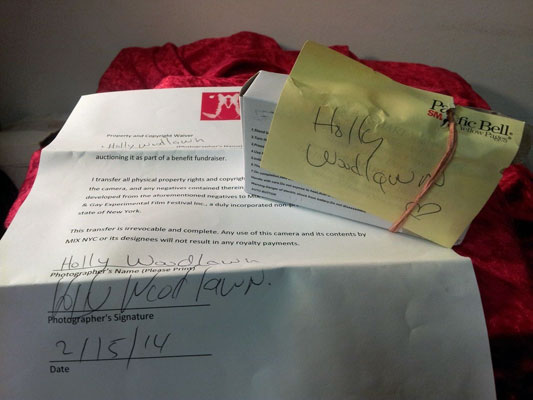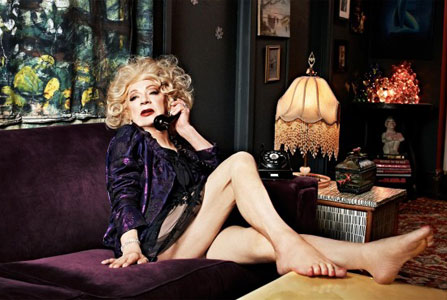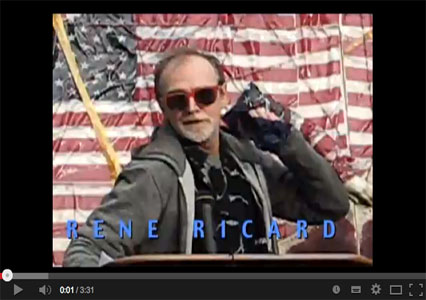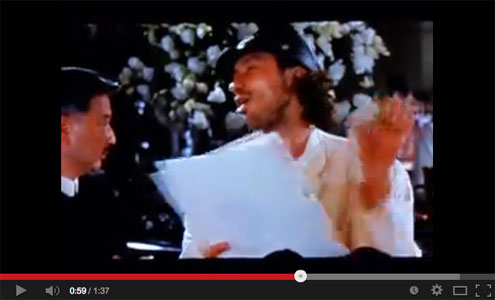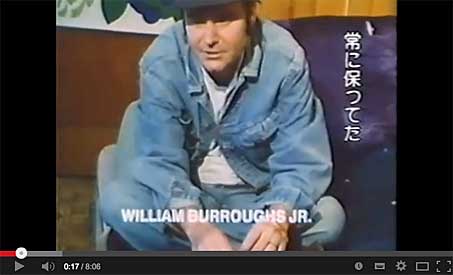
January - June 2014
R.I.P. Ultra Violet
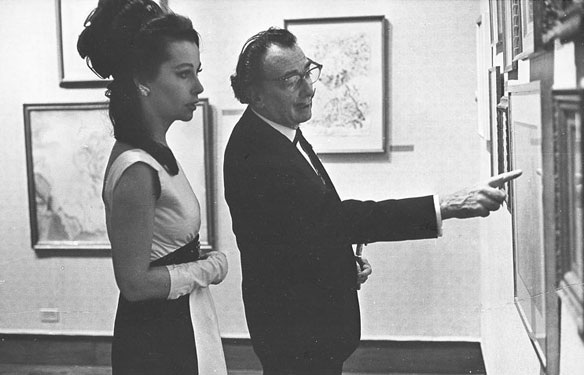
Ultra Violet and Salvador Dali
Andy Warhol superstar Ultra Violet (Isabelle Collin Dufresne) died of cancer at Beth Israel Hospital, New York on the morning of 14 June 2014. According to the Salt Lake Tribune, her funeral was held at a Mormon chapel in New York on Wednesday 18 June 2014. (Salt Lake Tribune article here).
Ultra was born on 6 September 1935. She appeared in a number of Warhol films, including I, a man, **** (Four Stars) and The Life of Juanita Castro. She also starred in classic underground theatrical productions such as Conquest of the Universe which also featured Ondine, Mary Woronov, Taylor Mead and Beverly Grant in the cast.
Ultra is sometimes referred to as having been sexually involved with the Surreal artist Salvador Dali, although she does not specifically claim this in her autobiography Famous for 15 Minutes: My Years with Andy Warhol. In her imaginatively written book, she does recount an incident where Dali caresses her with a lobster during a nude modelling session but she ends the account with the "The good thing about it is that it is safe - there is no way I can get pregnant." (UV71)
According to Roberta Smith in the New York Times, Ultra did, however, have an affair with the artist, John Graham. Graham's correspondence with Ultra is among his papers in the Smithsonian's Archives of American Art.
After becoming disillusioned with the Warhol scene, Ultra turned to art. Her work is currently included in the "Mises en Scène," exhibition at UMAM, , Château Musée Grimaldi, Cagnes-sur-Mer, France (June 7 – 21 November).
Ultra Violet:
"I realize how sharply the world has shifted when I am invited in 1977 to a private party at Studio 54 on West Fifty-fourth Street, at that moment New York's most in sanctum. I reach into my closet for a suitable outfit and pull out a pink satin nightgown of the 1940s and its matching long jacket with exaggerated shoulders. It will do.
The place is garish, frantic, ear-pounding, in the usual disco manner. It's four in the morning. The game is to see who's there. Everyone's playing it. I spot Andy and Truman Capote standing off to one side...
Since my breakdown I have viewed life with a survivor's eyes. I want an end to the violence and cruelty. I Iook around at all the barren glitter. I wonder: Do I really have higher values now? Or have I just lost my sense of fun? Am I jealous of the eighteen-year-olds I can no longer compete with? Has my immunity to cynicism run out? Yes, I think it has. I know it has. I feel a chill under the hot lights. The writhing bodies around me conjure up images of Sodom and Gomorrah. I pull my nightgown jacket closer around me.
Why am I squeezed into this sordid place in this drunken, drugged, uncaring crowd, in an out-of-date nightgown? It is ludicrous. I have to leave. I don't even stop to say goodbye. I doubt that either Andy or Truman notices that I am gone." (UV39-40)
Film-Makers' Cinematheque
9 June 2014: I've add to the site an essay on the history of Jonas Mekas' Film-Makers' Cinematheque which includes pre-Cinematheque screenings by Mekas at venues like the Charles cinema. Although many film writers have, in the past, referred to midnight screenings at The Charles where filmmakers brought their own films, a review of the advertising in the Village Voice reveals that most of the weekend midnight screenings were devoted to work by single artists - such as Marie Menken, Shirley Clarke and Stanley Vanderbeek. Also interesting to find out that the 41st St. Theatre was the same venue as the 42nd St. Cinema which was the same venue as the New Cinema Playhouse. Likewise, The Bridge was the same venue as the New Bowery.
In the essay, the Flaming Creatures controversy is also revisited although it's still not clear whether the Belgium film festival which refused to screen the film took place on a boat called "Casino" as suggested by some sources or in an actual casino as suggested by other sources.
Because the Cinematheque changed locations so often, it can be confusing when writers refer to a film opening at the Cinematheque but hopefully the essay clarifies what venue was used during what year and, in the future, it might be more useful to specify the actual venue a film opened at rather than just writing the "Cinematheque." For instance, instead of writing that The Chelsea Girls opened at the "Cinematheque," it would make sense to write that it opened at the Cinematheque when the Cinematheque was operating at the 41st St. Theatre (as per the ad below.) (Also worth noting that when Mekas wrote about or advertised the Cinematheque, he did not use any accents above the letters. Some writers used the accents when Mekas did not - such as David Bourdon in his biography of Warhol.)
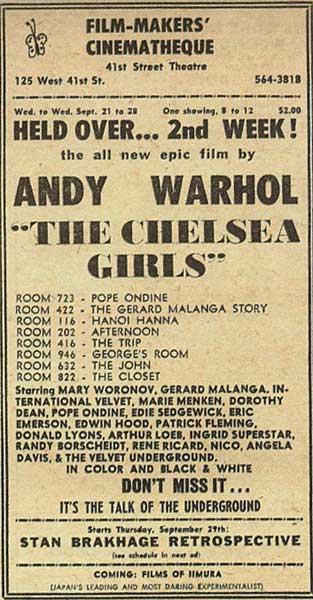
Village Voice, 22 September 1966 (Village Voice ad showing that The Chelsea Girls was held over a second week after it opened at the Cinematheque when the Cinematheque was at the 41st Street Theatre (Reproduced in The Inevitable World of The Velvet Underground (ed. Alfredo Garcia))
The full essay is here.
Holly Woodlawn's signed camera with original negatives is being auctioned on Ebay - auction ends 22 May
20 May 2014: A signed, disposable camera used by Holly Woodlawn - including all of the private shots on the film inside - is being auctioned on Ebay. The item is part of the Naked Eye Camera Benefit for Mix NYC. To bid, go here.
Gerard Malanga in Glasgow
12 March 2014: Gerard Malanga will be appearing at the The Poetry Club in Glasgow, Scotland on 4 April 2014 at 10 pm. The Poetry Club is located at Eastvale Place, Glasgow G3 8QG/Telephone: 0141 357 7246. Facebook page here.
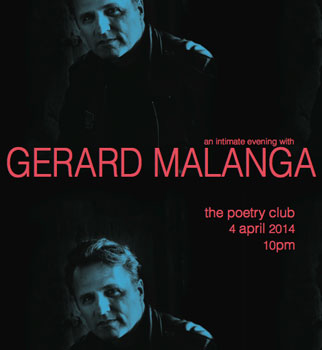
Gerard Malanga at The Poetry Club
The Brig
9 March 2014: There will be a showing of Jonas Mekas' film of the Living Theatre's production of The Brig, at Soho House, 29-35 9th Ave. NY (at 14th St.). Mekas and MM Serra will be participating in a Q & A after the screening. Free admission by RSVP to filmmakerscoop@gmail.com or (212) 267-5665.
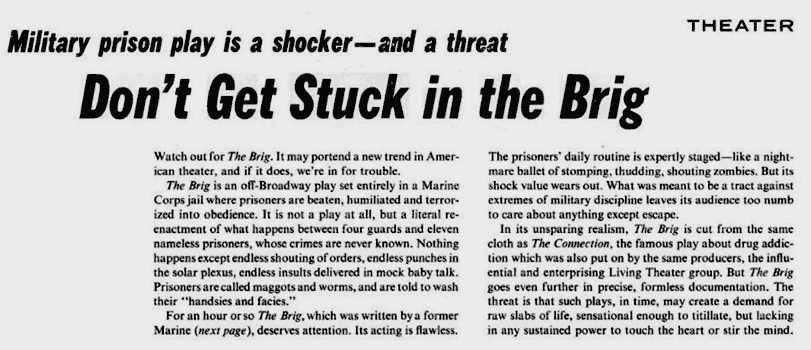
The beginning of the August 16, 1963 Life magazine article on the Living Theatre's production of The Brig
Jane Holzer
In case you missed it, an interesting article on Jane Holzer and the Holzer/Warhol exhibition in West Palm Beach, Florida, has appeared in the January issue of W magazine. In the interview, she says that she has been consulted on a film about Andy Warhol's life and suggests that "Ethan Hawke would make a good Andy.” She also mentions that she was executive producer on Harmony Korine's film, Spring Breakers. (Korine wrote the screenplay for Larry Clark's Kids and wrote and directed one of my favourite films, Gummo.) The Holzer article (with slideshow) is here.
Holly Woodlawn
6 March 2014: An interview with Holly Woodlawn (by James Anderson) has appeared in Ponystep here.
Holly Woodlawn in Ponystep
(Photo: Danielle Levitt/Styling:
Lester Garcia)
Bike Boy and My Hustler
25 February 2014: I've revised the essays on Bike Boy and My Hustler. My Hustler is here. Bike Boy is here.
The Andy Warhol Museum in Slovakia
An article on the Andy Warhol Museum in Slovakia (aka the Warhol Family Museum etc...) has appeared in the Daily Telegraph here.
Opening Party for the Piero Heliczer show curated by Jonas Mekas and Johan Kugelberg is tomorrow 20 February 2014
19 February 2014: The opening party for Piero Heliczer & The Dead Language Press will take place tomorrow evening from 6 pm - 9pm. The exhibition runs from 21 February - 14 March. Details here.
Note that they are including a DVD of Piero Heliczer/Walter Cronkite — The Making Of An Underground Film with all pre-orders of the publication that accompanies the exhibition, Piero Heliczer & The Dead Language Press – A Bibliography.
Gregory Battcock
17 February 2014: I recently came across an interesting Gregory Battcock page which includes a segment of the graphic Soho News account of his death. Battcock appeared in at least three of Warhol's films - Batman Dracula, Horse and Eating Too Fast (aka Blow Job No. 2)
Presumably it was the Soho News account that David Bourdon used when he wrote in his Warhol biography that Battcock, "noted for his risky habit of picking up rough trade, had been stabbed 102 times:"
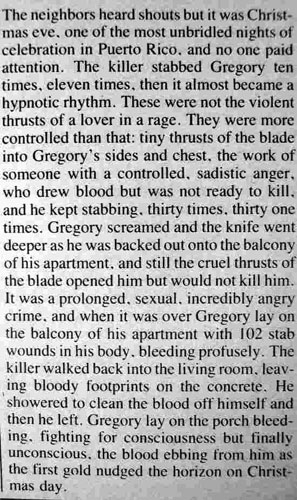
The only problem is that the in order for the writer to have known so many details, he probably would have had to have been there - which he wasn't. In the ordinary press, Battcock's murder was treated with considerably less drama:

The News and Courier - The Evening Post, Charleston S.C., 27 December 1980
Also came across what appears to be a photo of Gregory Battcock in an article by Gregory Battcock inscribed to Brigid Berlin - go here:
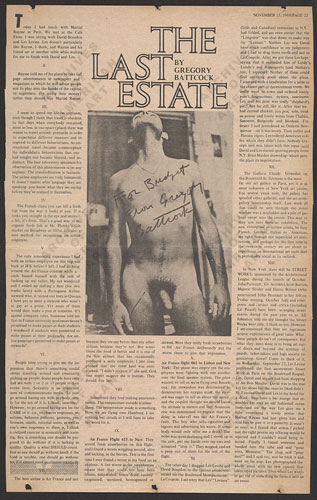
Reading Warhol
15 February 2014: I've been reading Reading Warhol - the exhibition catalogue from the show of Warhol 'literature' that closed last month at the Museum Brandhorst in Munich. (It ran from 18 September 2013 to 12 January 2014 - curated by Nina Schleif who also edited the catalogue.) It includes Warhol's book jackets, his early promotional books and the books he 'authored' (or which were at least designated as having been written by him).
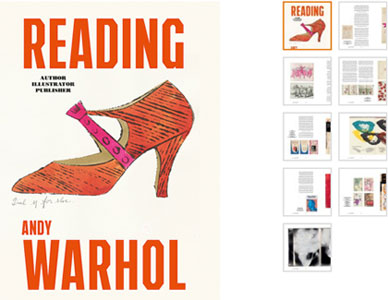
Front cover of Reading Warhol and 9 images from the book
Although I initially thought that the book and exhibition might be yet another attempt at re-packaging a familiar subject, I was pleasantly surprised to see that there was new information in it (including the re-dating of at least one promo book) and quite a number of images I had never seen before. Most people reading this are probably already aware of Warhol-designed book covers such as the Ronald Firbanks book, Pistols for Two by Marc Stein etc... but what about The Runaway Pigeon, Love is a Pie, Who Cooked Mother Goose, According to the Evidence, The Immortal, Forbidden Childhood, Here Lies the Heart, The Madhouse in Washington Square and The Summer Dancers? All had covers designed by Andy Warhol which are reproduced in Reading Warhol.
There are also images from "Leroy, the Mexican Jumping Bean," a collaboration between Warhol and Philip Pearlstein from their college days:
Nina Schleif:
"The seriousness with which Warhol approached the task of designing several sample pages of a text by his friend Philip Pearlstein, 'Leroy, the Mexican Jumping Bean,' while at college is impressive... The three surviving double-page spreads show that he was doing more than completing a homework assignment; rather, the young artist was trying to demonstrate that he was prepared for his career... As far as we know, Warhol and Pearlstein thought up the story themselves. Pearlstein wrote the prose text (although in what order the three pages should be read remains unclear): 'Leroy was bought by a man who wanted to make his children happy. Leroy made the children happy./ One day a bug crawled on top of Leroy's shelf and told him about the beautiful world outside./Leroy was unhappy.'" (p. 17)
There are twelve essays in the book including ones by Matt Wrbican of The Warhol museum and Reva Wolf who wrote Andy Warhol, Poetry, and Gossip in the 1960s. The first two are by curator Nina Schleif who identifies eight self-published 'promo' books by Warhol: Love Is a Pink Cake, A is an Alphabet, 25 Cats Name Sam an One Blue Pussy, À la recherche du shoe perdu, In the Bottom of My Garden, A Gold Book, Wild Raspberries and Holy Cats by Andy Warhol's Mother. According to Schleif, "it appears that, with the exception of 1958, one book a year was printed between 1952 and 1960." (p. 79) She then goes on to identify seven other manuscripts that were unpublished:
Nina Schleif:
"... there came about unpublished manuscripts that we know today only as unique copies... Seven such projects that were held up held up in the planning stage are known at present: 'The House That Went to Town,' 'Mrs. Cook's Children,' 'There Was Snow on the Street and Rain in the Sky,' two alphabet books ('abecedaries'), 'Velvet the Poodle,' and 'Horoscopes for the Coc[k]tail Hour.' Original drawings on blue paper are extant for the first two. The paper as well as the drawing style and the handwriting support a date of around 1952, parallel to 'A is an Alphabet' and 'Love Is a Pink Cake.' Except for 'Horoscopes,' none of the projects are mentioned by Warhol's contemporaries, making source material even sparser than is the case with the printed books." (p. 80)
She identifies Ralph T. Ward (aka "Corkie") as the co-author of A is an Alphabet, Love Is a Pink Cake, The House That Went to Town, and There was Snow on the Street and Rain in the Sky and and plausibly the author of the rhymes in Mrs. Cook's Children. She also notes the existence in Ward's literary estate of "a letter from the publishers Grosset & Dunlap to 'Miss' Andie Warhol, rejecting two children's book manuscripts for publication. (p. 84)
When discussing Wild Raspberries she also mentions the existence of another manuscript - The Andy Warhol Cook Book - "which can be dated to 1965." (p. 123)
Nina Schleif:
[The Andy Warhol Cook Book]... is a recipe collection extant in typescript; compared with Frankfurt's recipes [in Wild Raspberries], it is exceedingly boring and conventional. All of the recipes use Campbell's canned soups. What little wit and humor there is to be found is in recipe names like 'Andy's Factory Stew' and 'Edie's Zucchini and Eggs'... The dating rests on the mention of Edie Sedgwick, who was Warhol's 'Girl of the Year' in 1965, and is affirmed by a reference in the foreword to an article on Warhol's affection for food that had then recently been published in Vogue. According to the foreword, Warhol had, in addition to art, 'a second fame... good food! Andy knows the art of cooking. After all, he did have to do something with the contents of those thousands of soup cans. Cooking with soup! Yes, it has been done before. Be never we feel with such flair. So we've persuaded Andy to take time away from his production line to recreate some of his favorite recipes using his favourite brand of soup.' There is every indication that it was a stroke of luck for Warhol that this banal book project never came to completion; it would seem that this cookbook could not hold its own alongside the marketing books Don't Count Heads and Fashion 10, with which Warhol was also involved." (p. 123)
Schleif also believes that Holy Cats by Andy Warhol's Mother was printed in 1960 as opposed to 1957 and that the soup can was considered as artistic subject matter prior to late 1961. In regard to Holy Cats, she notes the discovery of a previously undisclosed invoice from Seymour Berlin's printing company dated 30 December 1960, charging $345 for a "Cat Book." According to Schleif, "The invoice suggests that Holy Cats - no other cat book by Warhol is known from the late nineteen fifties - was not printed until 1960, as opposed to 1957 or 1958, as art historians have previously assumed." (p. 124)
In regard to the soup can, many Warhol writers have accepted that the idea came from Muriel Latow. Schleif presents a drawing of two Campbell's soup cans by Andy Warhol's mother which she believes may predate the Latow story and notes:
Nina Schleif:
On a large sheet of paper, two cans of Campbell's Soup are shown and are labelled as such in Julia's hand. The can at the right is labelled 'wery gut' in a peculiar English-German. A cat holds onto this can with its claws, and another smaller cat floats on the page beneath it. This drawing is undoubtedly an early encounter between the Warhol family and the famous soup can. The question is, how early? Warhol's work with the motif, which was to afford him his breakthrough as an artist with thirty-two canvasses in 1962, has been dated to late 1961 on the basis of the story told by Muriel Latow, the woman Warhol paid $50 for the idea. This drawing revitalizes the truth value of the traditional version, since it shows that the soup can came up as artistic subject matter for the Warhols earlier than has been thought. (p. 130)
Unfortunately the mother's drawing of soup cans is undated. Might she have drawn it after Warhol started his soup can series? On the other hand, I have always had my own doubts about the Latow story. The source of the story was Ted Carey. According to Warhol biographers Tony Scherman and David Dalton the cheque to Latow was dated the 23rd of November, but Carey mentions that he had visited Oldenburg's "The Store" downtown earlier in the day. "The Store" didn't open until 1 December. (See "The Origin of Andy Warhol's Soup Cans or The Synthesis of Nothingness.") Also, Carey offers the claim about the soup can almost as an afterthought. His main claim was that Latow came up with the idea of painting money - which is unlikely for the reasons stated in my essay.
All the essays are footnoted, of course, and some of the most interesting tidbits of information are contained in the footnotes. Footnote 39 in Matt Wrbican's essay has this interesting information about Warhol's financial situation:
Matt Wrbican:
"Judging from the evidence in Time Capsule 39, Warhol's business dealings were notably complicated in 1967. All of that year he was shooting his '24 Hour Film' (now known as as Four Stars)... The bills for the raw stock, processing, and printing were fairly staggering, and it was screened just once, on December 15. A few days later, Warhol signed a five-year lease on a new studio at 33 Union Square West, with a monthly rent increase from $325 to $416 (for all of these figures keep in mind the value of a U.S. dollar then as compared with today). At the same time he had accumulated $6,300 in unpaid lawyer's fees. Carbon copies of checks found in Time Capsule 39 show that Warhol paid his superstars, the Velvet Underground, and for film services in 1967 more than $8,500; these are certainly only a partial accounting, given the haphazard nature of the Time Capsules. He also received $15,000 for producing his film Sunset, but his bank account was overdrawn by almost $700 near the end of September, despite having received almost $45,000 in fees from his primary art dealer, Leo Castelli Gallery, in 1966." (p. 200 fn39)
Warhol is often portrayed as somebody who skimped on money and didn't pay his superstars (what underground filmmaker did?) but these figures tell a slightly different story. $8,500 in 1967 would be equal to more than $60,000 in 2014 and that was only a partial accounting of how much he spent on superstars and film services. Given the Castelli income, it was bound to be a lot more. People may have thought he was sitting on a fortune but he was actually overdrawn by almost $700 - about $5,000 in 2014 terms.
There are quite a few interesting tidbits of information in this book. The only bothersome detail is the fact that each line of text is centred (why?) which makes reading it a bit awkward. Definitely worth a read though.
Expanded Cinema Mach II
I've received new information/documents and have expanded my original essay, "Expanded Cinema?," but the conclusion remains the same. Given that it was advertised as the New Cinema Festival at the time, and given that Jonas Mekas referred to it as the New Cinema Festival in his Village Voice columns at the time, the name of the festival was the New Cinema Festival and not the Expanded Cinema Festival. In fact, I can't quite understand how writers came to refer to it as the Expanded Cinema Festival when writing about it historically.
This doesn't mean that Mekas should not be credited with introducing the term "expanded cinema." He used it in at least three articles in 1965 which was five years prior to the publication of Gene Youngblood's book Expanded Cinema. Youngblood's definition of expanded cinema also differs slightly from that of Mekas. Youngblood borrowed heavily from the lingo and concepts of R. Buckminster Fuller and John McHale. Mekas' conception of expanded cinema is defined in the press release I've added to my essay. For Mekas, expanded cinema had to do with "multiple screens, multiple projectors; multiple imagery; changing screen and image shapes; merger of live performers and sound action; multiple exposures; moving slides; kinetic sculptures; hand held projectors; balloon screens; videotape; video projections; various light and sound experiments; etc." Youngblood emphasized the techno-psycho element: "When we say expanded cinema we actually mean expanded consciousness. Expanded cinema does not mean computer films, video phosphors, atomic light, or spherical projections. Expanded cinema isn't a movie at all: like life it's a process of becoming, man's ongoing historical drive to manifest his consciousness outside of his mind, in front of his eyes. One no longer can specialize in a single discipline and hope truthfully to express a clear picture of its relationships in the environment. This is especially true in the case of the intermedia network of cinema and television, which now functions as nothing less than the nervous system of mankind." (GE41)
R.I.P. Rene Ricard
2 February 2014: The poet, art writer, artist and Warhol star, Rene Ricard, died yesterday in the early morning on 1 February 2014 of cancer. He was born in Acushnet, Massachusetts, in 1946.
Rene Ricard reads a poem on You Tube here
Journalist Zoë Lescaze writes of Ricard's ordeal with cancer, quoting his friend, the artist Brice Marden, on the Gallerist website:
Zoë Lescaze:
"According to Mr. Marden, Ricard was experiencing difficulty walking and went into the hospital about a week ago for a hip replacement. 'When he went in they found there was all this other stuff,' said Mr. Marden, who added that Ricard’s death was unexpected. 'He was going to be starting chemotherapy, but he didn’t get it in time.
Mr. Marden, who visited Ricard in the hospital where he was surrounded by friends, said Ricard had been in good spirits. 'When I saw him he was really up to it all,' Mr. Marden said. 'He was obviously in bad shape but he was really enjoying the company.'"
Ricard was also friends with the artist Jean-Michel Basquiat and effectively put him on the art map (along with Keith Haring) with a 1981 article he wrote for the December 1981 issue of ArtForum magazine called "The Radiant Child." (A copy of the article can be found here)
Phoebe Hoban (Basquiat: A Quick Killing in Art (NY: Viking, 1998, p.88-89))
"Downtown poet and art critic Rene Ricard made a habit of hanging around and begging Jean-Michel for work. 'Please,' he would plead. 'I love this one. Give it to me. I deserve it.' Ricard truly appreciated Basquiat's work - and his body. He loved to walk around talking about the size of Basquiat's cock.
But it was Rene Ricard who scripted the star's formal introduction to the art world. In his long and elegiac article, 'The Radiant Child,' published in ArtForum that December, Ricard wrote, 'He has a perfect idea of what he is getting across...'"
Ricard was played by Michael Wincott in the film version of Basquiat's life:
Michael Wincott playing Rene Ricard in the film, Basquiat, with the real Michael Chow playing Michael Chow at the real Mr. Chow's restaurant
Ricard had, according to Hoban, first come across Basquiat's work at Maripol's loft after having been "picked up by a young boy at an after-hours club." (p. 93)
Ricard was active in underground cinema from the 60s onwards. In addition to appearing in Warhol's Kitchen, a Screen Test, The Chelsea Girls and Four Stars, he also played Warhol in The Andy Warhol Story. In one of the reels included in Four Stars called "Ultra," he pretends to be Susan Bottomly. He also appeared in the work of other underground filmmakers. He was in Warren Sonbert's Hall of Mirrors (1966), Piero Heliczer's Joan of Arc (1967) and Gerard Malanga's Pre-Raphaelite Dream (1968). (ST162) He was also in Eric Mitchell's 1980 film, Underground U.S.A., with Patti Astor, Cookie Mueller, and Taylor Mead. More recently, he appeared in the 2009 film, You Won't Miss Me, with Stella Schnabel (who co-wrote it with the director Ry Russo-Young).
But what first attracted Rene to the world of Warhol was not the possibility of appearing in his films. His attraction to Warhol had more to do with a Flower painting:
Rene Ricard:
"To support myself as a kid, I was a model at art schools around Boston. When I stopped working at 2 P.M., I'd walk up Newbury Steet, which is where the art galleries were. One day, I was at a gallery run by a friend and she said, 'Rene, there's something you've got to see over at the Institute of Contemporary Art.' I walked in, and there was a painting by Andy Warhol, the flower painting. It was orange, yellow, fuchsia, red, and green, and it looked enormous. Paintings weren't that big at that time — this was '64 — and, while looking at it, I evolved a theory about it. Andy had made a painting that was essentially flawless, but it was an actual painting. So he had this green background, and orange, yellow, fuchsia spots which were kind of pushing forward — they looked like they popped. I had never seen anything like it. I was in a trance. The guard tapped me on the shoulder and said, 'Excuse me, but the gallery's been closed half an hour. I completely planned out my life looking at that painting." (VS)
After he moved to New York at the age of 18, it was Bibbe Hansen's father, the Fluxus artist Al Hansen, who encouraged him to go to the Factory.
Rene Ricard:
"I ran into the artist Al Hansen on the street and I said, 'How do you know Andy Warhol?' He said, 'Just go up there! He's a really nice guy!' He gave me the address and explained how to use the elevator. I just walked in to Andy Warhol, Chuck Wein, Edie Sedgwick, and Billy Linich." (VS)
Ricard characterized the Factory as "a vicious cabal of warring factions:"
Rene Ricard:
"... the Factory was a vicious cabal of warring factions. The Factory was extremely cold, and I got in a lot of trouble at the time. First, Danny Williams was at the Factory and Paul Morrissey did the camera work on Kitchen, that was his first entrée. He was coming in as a technician, and he was a filmmaker himself. We ran out of film, and everyone was packing up. Danny Williams was supposed to pack up the film but he forgot it. Paul went instead, got the film, and that was the beginning of Paul Morrissey. Danny Williams, who was fired — a week later they found his car parked by a reservoir in Massachusetts, and he had drowned himself. As I said, the Factory was a cold, frightening, forbidding place. I mean, it was all silver! It was frigid. What I remember is the toilet door had a life-sized picture of Paul Anka, and someone had shoved a banana in his fly. That's the toilet where Ondine shot up Judy Garland, who said, 'I'll take anything to be with people.'" (VS)
Warhol referred to Ricard in his diaries numerous times, including the following three entries:
Andy Warhol (The Andy Warhol Diaries (NY: Warner Books, 1989):
25 January 1979: "Brigid was down to 120 but I caught her eating in Bob's office, everything that's bad for her - fried potatoes, fried scallops, mayonnaise. She was getting ready for the Shadows opening all day, she went home and put on all her jewellery... They were sending a limo for me and it came at 5:00. I glued, and took some of the kids down there with me. It was snowing a little...
But it turned out that out of the 400 people Bob invited, only 6 came. Six out of 400: Truman Capote, the Eberstadts, Fereydoun Hoveyda, who just resigned as ambassador, and the Gilmans. So 394 of our best friends were no-shows...
It turned out to be more of a punk opening, all the wonderful usual fantasy kids that go to openings like that. And Rene Ricard was there. Mrs. de Menil came, and she was sweet, and François, he was sweet. But Addie and Christophe de Menil didn't come. David Bourdon and Gregory Battcock, it was fun to see them, but we didn't get a chance to talk...
The bathroom was crowded, I guess people were coking up. We got a group together to go to dinner... We were limoing to 65 Irving Place to '65 Irving'...
Philippa invited Rene Ricard - her Dia Foundation just signed him up for benefits as the first poet - so he arrived at 65 Irving and was saying that my work was just too 'decorative.' That got me really mad, and I'm so embarrassed, everybody say the real me. I got so red and was telling him off, and then he was screaming things like that John Fairchild, Jr. was my boyfriend - you know how horrible Rene is - and it was like one of those old Ondine fights, and everybody was stunned to see me so angry and out of control and screaming back at him. And do you know that Rene has an agent now? And do you know who that agent is? Gerard Malanga. And I mean, Rene acts as if he's such a wonderful writer, but he just has one idea and he keeps repeating it over and over - about how he's winded and dined by the rich and how you should get things for free, that same old stuff. (AWD199)
3 February 1983: "Went to de Antonio's show at Parsons with Jon... Then to the Keith Haring opening (cab $4). It was on the Lower East Side, at the Fun Gallery, it's called. So we walked into the place and there's Rene Ricard, and he's screaming, 'Oh my god! From the sixties to the eighties and I'm still seeing you everywhere!' And I said how could he have said all those awful things about me in the Edie book and he said that I should have seen it before they cut it." (AWD484)
28 January 1984: "Wandered to the East Village. Took a couple of rolls of film. Ran into Rene Ricard who's the George Sanders of the Lower East side, the Rex Reed of the art world - he was with some Puerto Rican boyfriend with a name like a cigarette. We went to the Fun Gallery, then went to the Lochran Gallery... And then we went to Mary Garage. What's the name of that gallery? Gracie Mansion. On Avenue A. And there were five fakes of mine there. Electric Chairs. And some Jackson Pollock fakes. I didn't say anything." (AWD551)
Numerous memorials to Rene Ricard have been posted on Facebook and Twitter since his death but one of my favourites is the posting by Corey Grant Tippen of a signed poem by Rene:
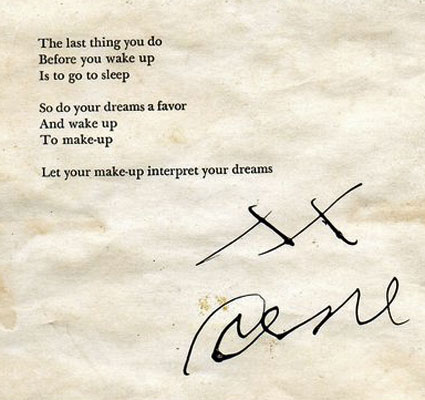
R.I.P. Rene Ricard.
Paul Warhola
Various news sources have now covered Paul Warhola's death, including the following:
"Andy Warhol's Brother Passes Away" (CBS Local)
"Obituaries - Notable Deaths" (The Washington Post)
"Smock man and brother of pop artist icon, dead at 91" (Herald Standard)
"Paul Warhola, brother of Andy Warhol and Navy veteran dies near Pittsburgh at 91" (Daily Reporter)
1 February 2014: Matt Wrbican of The Warhol museum has written an excellent account of Paul Warhola's life which you will find here.
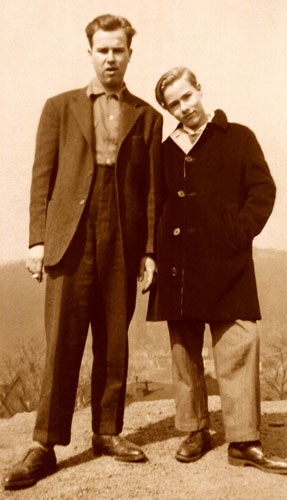
Paul Warhola (L) with his brother Andy
The Republic newspaper and the Pittsburgh Post-Gazette have also published obituaries for Paul:
Other news: There will be a memorial for Arthur C. Danto at St. Paul's Chapel at Columbia University on 6 February. Details here.
Bob Colacello will be introducing a screening of Lonesome Cowboys on 10 April 2014 at the Film Forum in New York. Details on the Film Forum calendar here.
I am searching for information on Potassa de la Fayette. If anyone knows what happened to her, can they please contact me at: garycom.now@gmail.com.
Yesterday, 31 January 2014, was Bibbe Hansen's birthday. Happy Birthday Bibbe with lots of love! xg
R.I.P. Paul Warhola
31 January 2014: Andy Warhol's oldest brother, Paul, passed away yesterday, 30 January 2014. Eric Shiner, the director of The Warhol museum who is currently in Tokyo for the opening of "Andy Warhol: 15 Minutes Eternal," is dedicating the opening to Paul. Shiner says, "I hope Andy, John and Paul are watching together!" Paul was born 26 June 1922. He and his wife Anne celebrated their 70th wedding anniversary in 2012. In addition to being Warhol's oldest brother, Paul was also the father of the illustrator James Warhola whose books include Uncle Andy's Cats and Uncle Andy's: A Faabbbulous Visit with Andy Warhol.
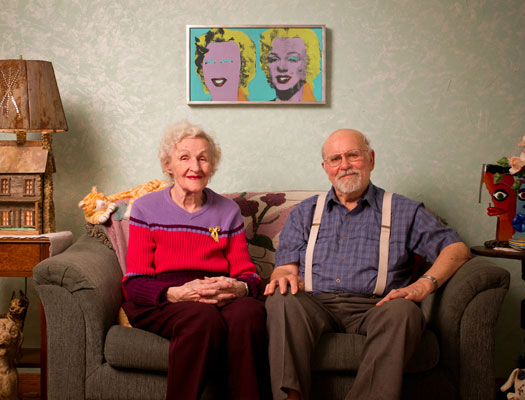
Paul Warhola and his wife Anne
Whatever Happened to Naomi Levine?
27 January 2014: A site user has contacted me, asking for information about Naomi Levine. For someone who was such a noticeable part of the '60s underground film movement in New York, she just seemed to fade away without trace. I heard awhile ago that she was doing a cable tv show and now this site user has contacted me because he may have traced her to New Mexico (possibly via Vermont) but that she has passed away. Does anyone know whether she ever lived on 74th Street in New York or have any information about her at all? If so, email me at garycom.now@gmail.com.
William Burroughs' son
I see that the new book on William Burroughs by Barry Miles, Call Me Burroughs, is out this week. The book should not be confused with the audio recordings of Burroughs that were released under the name Call Me Burroughs or the free podcast under that name on itunes here. (Scroll down to "Call me Burroughs.")
Haven't had a copy of the book but I enjoyed the review in The Boston Globe. What struck me most was the stuff about his son - no, not the fake son and Warhol star Julian Burroughs, but the real son, William Burroughs Jr. (The fake son, Julian Burroughs, was actually a draft dodger named Andrew Dungan and appeared in Warhol's Lonesome Cowboys and The Nude Restaurant.)
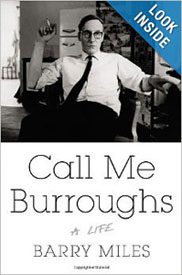
Apparently, Burroughs son, Billy, was born addicted to amphetamines. Billy had a small amount of success as the author of Speed (1970) and Kentucky Ham (1973).
Matthew Gilbert "Book review: 'Call Me Burroughs by Barry Miles,'" The Boston Globe, 25 January 2014):
"Miles gives a brief sketch of the son Burroughs had with Joan, and it, too, is sad. After Joan’s death, William Burroughs Jr., who had to be weaned off amphetamines after he was born, was raised by Burroughs’s parents. Burroughs rarely saw Billy Jr., and in 1981 Billy’s life of pain, for which he blamed his father, was cut short by severe alcoholism. 'Burroughs refused to accept that by killing the boy’s mother he had destroyed Billy’s life,' Miles writes. Burroughs’s first response to the death was to score heroin, despite being on methadone at the time."
William Burroughs Jr. can be found on You Tube here
The most interesting account of William Burroughs Jr. that I've come across is in an excellent book called When I was Cool: My Life at the Jack Kerouac School by Sam Kashner. In an effort to escape from suburban life on Long Island Kashner enrolled in the Jack Kerouac School of Disembodied Poetics at the Naropa Institute in Colorado only to find out that he was the only student. As Kashner put it, "In my last year of high school, my parents were hoping my grades would be good enough for me to go to Hofstra. But I didn't want to stand on the overpass and look down on Hempstead Turnpike. I wanted to burn like a roman candle, or at least a shabbas candle. I wanted to feel myself burning up with life. I wanted the Beat experience, but I didn't want to get hurt. I wanted Naked Brunch."
William Burroughs (senior) was one of the teachers, along with Allen Ginsberg and other Beats like Gregory Corso and Anne Waldman. By 1976 when Kashner arrived at the school, however, they were more like Beat 'has-beens':
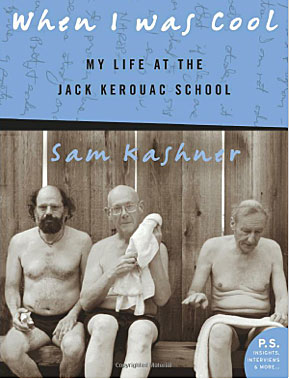
Sam Kashner:
"What I didn't quite realize as I packed my bags for the Kerouac School was that Ginsberg, Burroughs, and the rest of the Beats were on the downward slope of their fame. Eleven years earlier, Allen had been crowned King of the May in Czechoslovakia. William Burrough's Naked Lunch, considered a classic novel of nightmare comedy, was nearly twenty years old. Because the core faculty had turned their autobiography into art, their fictional selves lived on in a kind of perpetual youth. But, as I would soon discover, they themselves had grown old. The Beats I would encounter at Naropa were long in the tooth, cranky, full of bowel complaints and the perils of advanced age." (p. 9)
One of the first things that Ginsberg asked Kashner to do was to finish a poem for Ginsberg about "giving Neal Cassady a blow job." (Kashner was straight.)
Quite a few counter-culture personalities make an appearance in Kashner's book. One of the visitors to the school was Diane di Prima. She called in on Kashner when he was looking after Ginsberg's apartment:
Sam Kashner:
"The phone rang. It was Diane di Prima. She was coming over to teach me how to write a play based entirely on chance... I was nervous about her impending visit. I still thought she was kind of scary. Reading about her sexual exploits made me even more afraid of her. I prepared Allen's place as if I were expecting Marilyn Monroe for dinner...
Diane said she wanted to cook and she seemed to know her way round Allen's kitchen. She took over. She said that when she was a teenager in New York, she used to make something called 'menstrual pudding,' just tomato sauce and potatoes, no meat and no spices, because she couldn't afford them then. You had to pretend there was meat and spices in the pot you were stirring. I asked how it got its name, and she explained that someone in the apartment she lived in at the time -'some cat named Jack' - called it that. Then she made spaghetti and garlic bread and poured us lots of wine.
My head was swimming. I never drank that much wine before... I said I was going to lie down, maybe on the couch. She said I should get into bed. She opened the windows. There was a delicious breeze; I could hear the trees outside bending. She said good night. Then she asked if she could get into bed with me for a few minutes... We lay there for a few minutes with our arms around each other, talking about something, about nothing. Before I knew it she was going down on me and I didn't do anything to stop her." (p. 170-71)
When Kashner met Burroughs (senior) he described him in a less than flattering light: "I... wondered what kept him out of the mad house. He seemed to hear voices. There seemed to be no line between Burrough's daily life and his dreams. He seemed to walk through his dream life the way we walk through our daily lives. How does he do it? I wondered. How does he avoid getting killed crossing the street?" When Burroughs' son Billy arrives, Kashner describes him as someone who "looked like a dying youth who had come to say good-bye." (p. 37) By the autumn, Billy "looked worse. A sad-looking guy, he looked even sadder as the weeks flew by. A skinny guy who used a rope to keep his pants up, he seemed skinner than usual. I thought his skin looked gray - blue and gray, the color of ash. There was some kind of bump in his neck. Something was wrong. The one who didn't seem to notice was his father. But Billy was used to his father not knowing what was wrong." (p. 146)
Billy Burroughs (from When I Was Cool):
"My father never said anything to me about his life... I learned it all from other people. He refuses to talk about anything real. He cultivates speaking to me in the clichés of parenthood. Things about being on the right track, and advice about how to drive around armadillos when it's late at night on the highway to Denver. Practical advice. He would play Hungarian waltzes and watch me, unblinking, for hours. I would ask him what he was thinking and he would tell me that he was trying to imagine what was going through Lincoln's brain when he was shot." (p. 43)
Billy died in 1981, at the age of 33, from alcohol related liver failure. His father died in 1993 at the age of 83. According to the author of a previous biography, Literary Outlaw: The Life and Times of William S. Burroughs, the senior Burroughs continued to use heroin in the early 80s before switching to methadone that he could obtain legally. The previous biography is excellent by the way - there's a good article about it's author, Ted Morgan, in the Huffington Post at: here.
Film Catalogue Raisonné Vol. 2
22 January 2014: I can remember Callie Angell saying to me about six years ago that I bet I didn't think I would still be doing this site after so many years. Well, here it is 2014 - thirteen years after I first started the site and I'm still doing it. Unfortunately Callie is no longer with us but her book - the first volume of the film catalogue raisonné - is still one of the most accurate books about the Warhol era in publication, dispelling many of the claims made about the films previously. Fortunately, her assistant Claire Henry is still on board for the second volume. In addition to Claire and Callie I think the most accurate writing on the Warhol era comes from Donna de Salvo (who, thank god, is curating the upcoming 2016 Warhol retrospective at the Whitney), and Matt Wrbican from The Warhol museum. I do hope that the next volume of the film catalogue raisonné will be every bit as good as the one written by Callie who is still often in my thoughts.
L'Amour
I can't help but wonder how the second volume will deal with the Paul Morrissey films. Will films like L'Amour be considered a Morrissey film, a Warhol film or, as it was billed on the poster, as being by both? A friend (thanks TK) recently sent me a 1972 article that placed Warhol firmly behind the camera during the shooting of L'Amour while Morrissey fed lines to the actors:
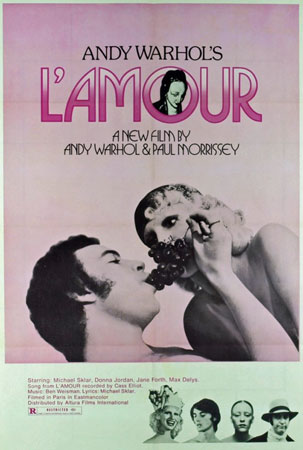
Sally Beauman (Telegraph Magazine, 5 February 1972, p. 428):
"Clearly there is going to be no nonsense about Motivation on this picture: Warhol switches on the camera, the tapes start recording as usual.
'What a beyootiful room zis ees,' says Max [Delys] obligingly, and he and Karl [Lagerfield] improvise their scene. Every time they seem in danger of drying up, or saying something that will throw the plot haywire, they stop the cameras, stop the sound, and Paul Morrissey suggests some more lines to them. Whenever anyone says anything in the least lively, and natural, so artificial is the atmosphere, it seems extremely funny.
'Now how about you tell him you've been having a little affair with his wife,' says Paul.
Max clears his throat, the camera rolls. 'Er, Karl,' he says, 'I zink maybe you should know, I make a leetle zing with Patti.'
Karl makes a delighted moue. 'I think I should know,' he says, 'what is a little thing?'
They improvise a few more sentences, then Warhol cuts off the camera. Everyone falls about. 'Did you hear that, hey that was great!' 'Make a little thing.' Did you hear that, Andy?' But Andy is invisible behind the camera."
Joe Dallesandro and Holly Woodlawn
Speaking of Paul Morrissey films, in Los Angeles this weekend the forever handsome Joe Dallesandro and the forever glamorous Holly Woodlawn hosted a special screening of their films at Hollywood Forever. It also included a screening of the documentary about Joe. The event was covered by L.A. Weekly and a slideshow of the activities can be found here.
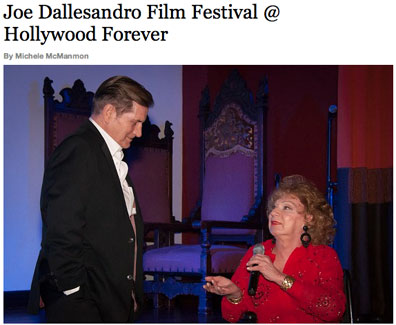
Joe and Holly at Hollywood Forever from L.A. Weekly
Joe thanked everyone involved on his Facebook page: "I want to take a moment to thank Paul Morrissey, Holly Woodlawn, Chanell O'Farrill, Tyler Cassity, and all the wonderful folks from Hollywood Forever for such a fantastic weekend event. And of course Kim Dallesandro who had the idea and helped put it all together."
Lou Reed Remembered
Holly could also be seen in the UK in December in a new Chris Rodley documentary shot after Lou's death - Lou Reed Remembered - which was broadcast on 15 December on BBC4. Rodley previously directed Andy Warhol: The Complete Picture. In addition to Holly, Mary Woronov also appeared - a true superstar. I had the privilege of meeting both of them when I moderated the superstar panel discussion for the Hayward Gallery and I wasn't disappointed - especially when Mary shouted out backstage before the show, 'Don't open the champagne before the show - Holly will drink the whole bottle!' it was nice to know that some things never change.
Expanded Cinema
In regard to Warholstars, I plan on spending a lot of this year updating the site - but be patient - since my hospital stay it takes me about ten million times longer to do anything. One thing I noticed was that over the years numerous film writers have referred to Jonas Mekas' "Expanded Film Festival." But there was no Expanded Film Festival. There was only the New Cinema Festival 1. See Expanded Cinema?
The Velvet Underground
I've also updated the bit on the Velvet Underground that mentions the expanded cinema. See:
here.
